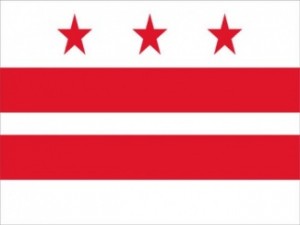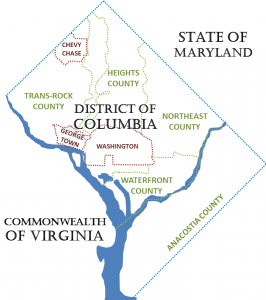 Statehood is a perennial issue in the District of Columbia, along with full enfranchisement of the residents of DC. It’s not for nothing that the District’s license place bear the motto “Taxation Without Representation.” Unlike other Americans, citizens of DC have no effective vote in Congress.
Statehood is a perennial issue in the District of Columbia, along with full enfranchisement of the residents of DC. It’s not for nothing that the District’s license place bear the motto “Taxation Without Representation.” Unlike other Americans, citizens of DC have no effective vote in Congress.
Interesting how all those Tea Party activists protesting in the District never made a big deal out of the taxation without representation right in front of their faces.
But, beyond all of the partisan politics behind adding a 51st star to the flag (DC is notoriously left-leaning and Democratic), a huge stumbling block in the DC statehood struggle is the fact that DC does not look or sound like a state.
Statehood advocates love to point out that DC has more citizens than Wyoming, but population does not a state make. DC’s internal organization and terms of self-reference give off a distinctly non-state-like vibe.
Americans outside of the nation’s capital look in and see an administrative enclave granted a degree of autonomy, not an equivalent to California or Texas. Or even tiny Rhode Island. Why?
Organization : What DC looks like.
A major reason is that, while it might have fewer citizens, Wyoming nevertheless has a state government, 23 county governments, and 99 incorporated municipalities. Next-in-size Rhode Island has a state government, five counties, and 39 municipalities. By comparison, DC has a single district-city government, headed by a mayor, and divided into administrative wards.
It didn’t used to be this way. The District once had two counties (one of which was lost to Retrocession) and distinct municipalities.
Step one to earning statehood cred would be to reorganize on a state-like model. The District government would have a governor and legislature, as well as a few counties headed by commissions and municipalities headed by mayors. I would suggest the District legislature be bicameral: one house by proportional representation to provide free constituencies, and the other house made of up representatives from much smaller Wards than the city has now, independent of counties and allotted by population.
Terms of Reference : What DC sounds like.
One trope often lobbed against the DC voting movement is the obvious observation that DC is “a district, not a state” and only states have the constitutional right to representation in Congress. Well, Virginia is officially a “commonwealth” and yet also manages to be a state, so this argument is as dumb as it is ill-motivated.
However, for DC to be seen as a potential state, it should adopt state-like terms of self-reference. Just as “Commonwealth of Virginia” is the official name of Virginia, “District of Columbia” would have to be seen as merely the official name of … yes … just plain old Columbia. And yes, residents would be Columbians. We’d just have to hyper-pronounce the second “O” when talking about the similarly named South American country.
“They are Col-oh-mbians, we are Col-uh-mbians.”
Even though “Washington” would henceforth refer officially only to the municipality of Washington (preferably somewhere near its original city boundaries clustered around the Mall) anyone in the metro area might fairly consider themselves Washingtonians, even if they live in Silver Spring or Arlington. However, the term “Washington, DC” would refer only to the municipality, alongside other potential cities like “Georgetown, DC”” and “Chevy Chase, DC.”
And, if you think Georgetown and Chevy Chase are too small to be cities, let me remind you that Wyoming has 99 incorporated municipalities with 100,000 fewer residents than DC. And, as many people live in downtown Washington as live in Virginia’s capital, Richmond (roughly 200k).
Visuals, please?
Here’s a rough sketch of what a state-like District of Columbia might look like:
Other DC ideas:
Optimizing the DC Metro (and other traffic-easing ideas)
Villenoire: A Jazz Age theme neighborhood

